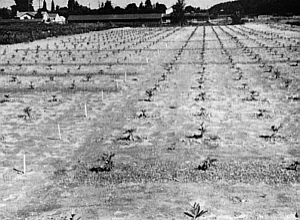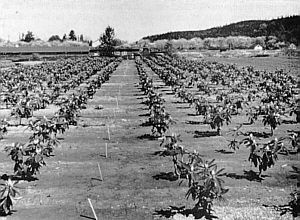QBARS - v18n2 The Effect of Phosphorus on Rhododendron Flower Bud Formation
The Effect of Phosphorus on Rhododendron Flower-Bud Formation
Arthur S. Myhre and W. P. Mortensen
Associate Horticulturist and Associate Soil Scientist, respectively
Western Washington Experiment Station, Puyallup, Washington
Good flower bud production on young rhododendron plants is a desirable requisite. Rhododendron enthusiasts throughout the Pacific Northwest have expressed a need for a fertilization program that will bring about this condition. since many varieties do not bloom well at an early age.
Nutritional investigations to determine the fertility requirements for rhododendrons when grown under field conditions have been underway at the Western Washington Experiment Station since 1958. Rooted cuttings of variety 'Cynthia' were set out on two different soil types and fertilized each year with various sources of nitrogen, phosphorus, and potassium applied at different levels. Phosphorus applications include incorporation with the soil before plant setting to furnish a five-year supply as compared to annual surface applications totaling similar amounts of phosphorus over the five-year period. Other treatments included additions of magnesium, minor elements, time of fertilization, and a comparison of sawdust mulch with no mulch. The effect of phosphorus on flower-bud production was predominant among fertilizer treatments and discussion is limited to it in this article. Results obtained from the other fertilizer treatments will be published in a Station Bulletin at a later date.
Figure 8 shows rooted cuttings of variety 'Cynthia' that were taken directly from the propagation frame March 18, 1958, set out in randomized, replicated field plots on a Puyallup loam soil (32 per cent sand, 47 per cent silt, 21 per cent clay), and fertilized with 30 different nutrient treatments.
This soil is alluvial, moderately acid, and in a medium-to-high state of fertility. Excellent weed control was obtained with the use of the herbicide, Simazine, applied as a pre-emergent spray in May. Figure 9 reveals the excellent flower-bud production obtained the following year and is illustrated in the close-up picture Figure 11.

|

|
|
Fig. 8. Fertilizer plots, rooted cuttings set
out in March, 1958, picture taken July, 1958. |
Fig.9. The same plants as in the picture
adjacent, photographed in Oct. 1959. |

|

|
|
Fig. 10. Non-fertilized plant showing
vegetative buds only. |
Fig. 11. Close-up of a fertilized plant
showing flower buds. |
It is evident from data shown in Table 1 that phosphorus plays an important role in flower-bud initiation. Most flower-bud increase occurred during the first three years with soil incorporation of a high rate of phosphorus (treatment 4) before plant setting. This treatment showed some advantage over yearly surface application of phosphorus (treatment 3) until 1962. A comparison between non-fertilized plants (treatment 1) and fertilized plants in which phosphate was incorporated (treatment 4) shows an approximate increase of flower buds of 83, 59, 47, and 28 per cent, respectively, for the four years following setting. A similar four-year comparison between non-fertilized plants and those fertilized annually with surface applied phosphate (treatment 3) shows increases in flower-bud number representing 77, 52, 38, and 27 per cent, respectively. Nitrogen also increased bud set (treatment 2) but the joint effects of nitrogen and phosphorus (treatments 3 and 4) were much greater in all experiments conducted. Potassium was ineffective (treatment 5) under conditions of this test.
|
Table 1. Effects of phosphorus on flower-bud formation.
1958-1962 fertilizer plots on Puyallup loam soil. |
|||||||
|
Treatment*
(lbs. per acre area) |
Number of flower buds per plant
(Average of 21 plants) |
||||||
| # | P 2 O 5 | N | K 2 O | 1959 | 1960 | 1961 | 1962 |
| 1 | 0 | 0 | 0 | 1.3 | 10.8 | 43.7 | 118.0 |
| 2 | 40 | 0 | 0 | 2.3 | 15.1 | 63.4 | 146.6 |
| 3 | 40 | 80 | 0 | 5.7 | 22.7 | 71.2 | 161.9 |
| 4 | 40 | 400 | 0 | 7.6 | 26.1 | 81.9 | 163.5 |
| 5 | 40 | 0 | 80 | 2.8 | 15.7 | 63.7 | 142.4 |
| 6 | 40 | 80 | 80 | 6.1 | 24.0 | 69.4 | 160.5 |
*Plants were spaced 3 by 4 feet. Treatment amounts were calculated for fertilizer needed to cover only 1 square foot area around each plant. Phosphorus (treatment 4) was applied in 1958 as a five-year supply (400 pounds P 2 O 5 = 816 pounds dicalcium phosphate, 49 per cent, per acre) and incorporated into soil previous to plant setting. Phosphorus (treatments 3, 6) was applied as surface applications in April of each year, totaling similar amounts of phosphorus over the five-year period (80 pounds P 2 O 5 178 pounds treble phosphate, 45 per cent, per acre). Nitrogen and potassium were also applied as surface applications in April of each year. Nitrogen (40 pounds N-190 pounds ammonium sulfate, 21 per cent, per acre) was increased from 40 pounds to 80 pounds in 1959, 1960, and to 120 pounds in 1961, 1962.
| Table 2. Effect of phosphorus source, rate, and time of application on flower bud formation. 1959-1963 fertilizer plots on Puyallup loam soil. | ||||||||
|
Treatment*
lbs. P 2 O 5 per acre area |
Number of flower buds per plant
(Average of 21 plants) |
|||||||
| Source | 1959 | 1960 | 1961 | 1962 | 1963 | |||
| 1 | 0 | 0 | 2.8 | 19.3 | 51.6 | 110.9 | ||
| 2 | 480 | dicalcium | 23.8 | 9.8 | 42.8 | 94.3 | 177.1 | |
| 3 | 480 | rock | 19.1 | 8.8 | 36.1 | 88.4 | 163.5 | |
| 4 | 480 | treble | 23.8 | 9.3 | 39.5 | 89.9 | 164.1 | |
| 5 | 480 | bone meal | 19.1 | 8.3 | 36.7 | 85.6 | 162.4 | |
| 6 | 80+ | treble | 38.1 | 10.5 | 41.3 | 87.2 | 167.9 | |
*Phosphorus (treatments 2-5) was applied in 1959 as a five-year supply incorporated into soil previous to planting and compared to yearly surface applications totaling similar amounts over the five-year period (treatments 6) starter solution = phosphoric acid, 52 per cent, applied at 1:100 dilution (1 cup per plant shortly after plant setting). Nitrogen as ammonium sulfate was applied as surface applications at rates of 40 pounds in 1959, 80 pounds in 1960, 1961, 120 pounds in 1962, and 1963. Potassium was applied as sulfate of potash at a rate of 80 pounds of K 2 0 each year.
Table 2 shows results obtained from certain nutrient treatments applied to rooted cuttings of variety 'Cynthia' that were set in field plots on the Puyallup loam soil April 5, 1959. As in the 1958-1962 fertilizer plots, fertilization had a very pronounced effect on flower-bud production. This effect was evident even in the year of setting and continued to show throughout the experimental period. The effect among the four phosphate sources was similar at the 480 P205 level. Added benefit was obtained from April over June fertilization (treatments 7 and 8). A starter solution applied in 1959 shortly after setting and combined with an annual surface application of phosphate improved early flower-bud formation over that of the surface application alone (treatments 6 and 7). The effectiveness of phosphorus was indicated by the fact that a larger number of plants produced a flower bud the same season in which the cuttings were set out (1959 column).
| Table 3. Effect of phosphorus rate and time of application on flower-bud formation. 1961-63 fertilizer plots on Puyallup sandy loam soil. | |||||||
| # |
Treatment*
(lbs per acre area) |
Phosphorus
source |
Time of
application |
Average number flower of buds per plant
(21 plants) |
|||
| N | P 2 0 5 | K 2 O | 1962 | 1963 | |||
| 1 | 0 | 0 | 0 | 0 | 4.2 | ||
| 2 | 40 | 480 | 80 | dicalcium | March | 3.5 | 25.6 |
| 3 | 40 | 480 | 80 | treble | March | 3.1 | 22.5 |
| 4 | 40 | 80 | 80+ | treble | April | 3.2 | 24.2 |
| starter solution | |||||||
| 5 | 40 | 80 | 80 | treble | April | 2.6 | 15.1 |
| 6 | 40 | 80 | 80 | treble | June | 0 | 7.4 |
*Plants mulched with fresh fir sawdust. Phosphorus (treatments 2, 3) was soil incorporated before setting; phosphorus in other treatments was applied as annual surface application. Nitrogen was furnished by ammonium sulfate and potassium by sulfate of potash.
Good response to phosphate treatments was also obtained on rooted cuttings of 'Cynthia' set out on a coarser textured soil March 27, 1961 (Table 3). However, it can be seen that the responses were of lower magnitude than in the other experiments. This is apparently due to the sawdust mulch used in conjunction with the listed treatments. It was observed from other treatments not shown that plants mulched with sawdust produced less flower buds than un-mulched plants. When the nitrogen rate was increased, however, flower-bud formation on mulched plants was comparable to that on plants without mulch. No doubt, a shortage of available nitrogen occurred with the usage of fresh fir sawdust. With added amounts and uptake of nitrogen, increased plant metabolic activity apparently increased subsequent phosphorus uptake.
As stated previously, little difference in effect is evident between treble superphosphate and dicalcium phosphate. Earlier application, in April, again was superior to later application in June. The effect of a starter solution of dilute phosphoric acid in combination with a surface application of phosphate was comparable to a higher rate of phosphate incorporated with the soil (treatments 3 and 4).
Summary
It is believed that the research findings presented will be of much interest and value to rhododendron producers. At the present time the greatest demand by home gardeners is for two- to three-year-old plants at which age many rhododendron varieties have poor flower-bud formation.
These studies indicate that poor flower-bud development is highly related to inadequate or improper fertilization practices. Among these, inadequate phosphorus fertilization appears most commonly at fault. In the absence of adequate amounts of phosphorus, rooted cuttings of variety 'Cynthia' failed to get off to a quick start and develop satisfactory flower-bud numbers within two or three years. This occurred on soils considered to be above average in available soil phosphorus content for western Washington. At least comparable results might be expected on most of our soils.
Efficiency of fertilization was unrelated to source of phosphorus employed-providing all were similarly incorporated with the soil. Heavy initial applications, with soil incorporation, were superior to light annual surface applications during the first two and three years. However, when the surface applications were combined with a starter solution of dilute phosphoric acid, no difference was measured in flower-bud set. Timing of annual treatments was found important, with April application superior to June.
Other factors, including the use of sawdust mulch and nitrogen, were also found important with regard to flower bud set. Details of these and other findings will be handled in a following publication.
Additional fertility studies are presently being conducted to see if other rhododendron varieties respond in the same way as the 'Cynthia' variety.
